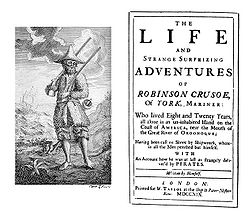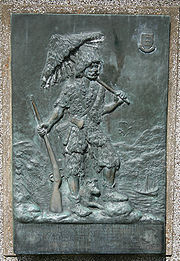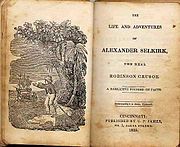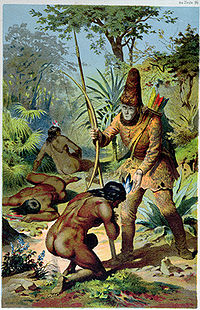
Robinson Crusoe
About this schools Wikipedia selection
This content from Wikipedia has been selected by SOS Children for suitability in schools around the world. SOS Children works in 45 African countries; can you help a child in Africa?
Robinson Crusoe is a novel by Daniel Defoe that was first published in 1719. The book is a fictional autobiography of the title character—a castaway who spends 28 years on a remote tropical island near Venezuela, encountering Native Americans, captives and mutineers before being rescued.
The story was perhaps influenced by Alexander Selkirk, a Scottish castaway who lived for four years on the Pacific island called "Más a Tierra" (in 1966 its name was changed to Robinson Crusoe Island), Chile. The details of Crusoe's island were probably based on the Caribbean island of Tobago, since that island lies a short distance north of the Venezuelan coast near the mouth of the Orinoco river, in sight of Trinidad. It is also likely that Defoe was inspired by the Latin or English translations of Ibn Tufail's Hayy ibn Yaqdhan, an earlier novel also set on a desert island. Another source for Defoe's novel may have been Robert Knox's account of his abduction by the King of Ceylon in 1659 in "An Historical Account of the Island Ceylon," Glasgow: James MacLehose and Sons (Publishers to the University), 1911.
Full title
Although commonly referred to as simply Robinson Crusoe the book’s complete, original title as it appears on the title page of the first edition is The Life and Strange Surprizing Adventures of Robinson Crusoe, of York, Mariner: Who lived Eight and Twenty Years, all alone in an un‐inhabited Island on the Coast of America, near the Mouth of the Great River of Oroonoque; Having been cast on Shore by Shipwreck, wherein all the Men perished but himself. With An Account how he was at last as strangely deliver’d by Pyrates.
Plot summary
Crusoe (the family name corrupted from the German name "Kreutznaer" or "Kreutznär") sets sail from the Queen's Dock in Hull on a sea voyage in August 1651, against the wishes of his parents, who want him to stay at home and pursue a career, possibly in law. After a tumultuous journey that sees his ship wrecked in a storm, his lust for the sea remains so strong that he sets out to sea again. This journey too ends in disaster as the ship is taken over by Salé pirates and Crusoe becomes the slave of a Moor. After two years of slavery, he manages to escape in a boat with a boy named Xury; later, Crusoe is rescued and befriended by the Captain of a Portuguese ship off the west coast of Africa. The ship is en route to Brazil. There, with the help of the captain, Crusoe becomes owner of a plantation.
Years later, he joins an expedition to bring slaves from Africa but he is shipwrecked in a storm about forty miles out to sea on an island (which he calls the Island of Despair) near the mouth of the Orinoco river on September 30, 1659. His companions all die, save himself, and three animals who survived the shipwreck, the captain's dog and two cats. Having overcome his despair, he fetches arms, tools and other supplies from the ship before it breaks apart and sinks. He proceeds to build a fenced-in habitation near a cave which he excavates himself. He keeps a calendar by making marks in a wooden cross which he has built. He hunts, grows corn and rice, dries grapes to make raisins for the winter months, learns to make pottery and raises goats, all using tools created from stone and wood which he harvests on the island. He also adopts a small parrot. He reads the Bible and becomes religious, thanking God for his fate in which nothing is missing but human society.
Years later, he discovers native cannibals who occasionally visit the island to kill and eat prisoners. At first he plans to kill them for committing an abomination but later realizes that he has no right to do so as the cannibals do not knowingly commit a crime. He dreams of obtaining one or two servants by freeing some prisoners; when a prisoner manages to escape, Crusoe helps him, naming his new companion "Friday" after the day of the week he appeared. Crusoe then teaches him English and converts him to Christianity.
After another party of natives arrives to partake in a cannibal feast, Crusoe and Friday manage to kill most of the natives and save two of the prisoners. One is Friday's father and the other is a Spaniard, who informs Crusoe that there are other Spaniards shipwrecked on the mainland. A plan is devised wherein the Spaniard would return with Friday's father to the mainland and bring back the others, build a ship and sail to a Spanish port.
Before the Spaniards return, an English ship appears; mutineers have taken control of the ship and intend to maroon their former captain on the island. Crusoe and the ship's captain strike a deal in which he helps the captain and the loyal sailors retake the ship from the mutineers, whereupon they intend to leave the worst of the mutineers on the island. Before they leave for England, Crusoe shows the former mutineers how he lived on the island and states that there will be more men coming. Crusoe leaves the island December 19, 1686 and arrives in England on June 11, 1687. He learns that his family believed him dead and there was nothing in his father's will for him. Crusoe departs for Lisbon to reclaim the profits of his estate in Brazil, which has granted him a large amount of wealth. In conclusion, he takes his wealth overland to England to avoid traveling at sea. Friday comes with him and along the way they endure one last adventure together as they fight off hundreds of famished wolves while crossing the Pyrenees.
Reception and sequels
The book was published on April 25, 1719. Before the end of the year, this first volume had run through four editions. Within years, it had reached an audience as wide as any book ever written in English.
By the end of the 19th century, no book in the history of Western literature had had more editions, spin-offs and translations (even into languages such as Inuit, Coptic and Maltese) than Robinson Crusoe, with more than 700 such alternative versions, including children's versions with mainly pictures and no text.
The term " Robinsonade" was coined to describe the genre of stories similar to Robinson Crusoe.
Defoe went on to write a lesser-known sequel, The Farther Adventures of Robinson Crusoe. It was intended to be the last part of his stories, according to the original title-page of its first edition but a third part, Serious Reflections of Robinson Crusoe was written; it is a mostly forgotten series of moral essays with Crusoe's name attached to give interest.
Real-life castaways
There were many stories of real-life castaways in Defoe's time. Defoe's initial inspiration for Crusoe is usually thought to be a Scottish sailor named Alexander Selkirk, who was rescued in 1709 by Woodes Rogers' expedition after four years on the uninhabited island of Más a Tierra in the Juan Fernández Islands off the Chilean coast. Rogers' "Cruising Voyage" was published in 1712, with an account of Alexander Selkirk's ordeal. However, Robinson Crusoe is far from a copy of Woodes Rogers' account: Selkirk was marooned at his own request, while Crusoe was shipwrecked; the islands are different; Selkirk lived alone for the whole time, while Crusoe found companions; while Selkirk stayed on his island for four years, not twenty-eight. Furthermore, much of the appeal of Defoe's novel is the detailed and captivating account of Crusoe's thoughts, occupations and activities which goes far beyond that of Rogers' basic descriptions of Selkirk, which account for only a few pages.
Tim Severin's book Seeking Robinson Crusoe (2002) unravels a much wider and more plausible range of potential sources of inspiration, and concludes by identifying castaway surgeon Henry Pitman as the most likely. An employee of the Duke of Monmouth, Pitman played a part in the Monmouth Rebellion. His short book about his desperate escape from a Caribbean penal colony, followed by his shipwrecking and subsequent desert island misadventures, was published by J. Taylor of Paternoster Row, London, whose son William Taylor later published Defoe's novel. Severin argues that since Pitman appears to have lived in the lodgings above the father's publishing house and that Defoe himself was a mercer in the area at the time, Defoe may have met Pitman in person and learned of his experiences first-hand, or possibly through submission of a draft.
Severin also discusses another publicised case of a marooned man named only as Will, of the Miskito people of Central America, who may have led to the depiction of Man Friday.
Interpretations
Despite its simple narrative style and the absence of the supposedly indispensable love motive, it was received well in the literary world. The book is one of the most widely published books in history. It has been popular since the day it was published.
Colonial
Novelist James Joyce noted that the true symbol of the British conquest is Robinson Crusoe: "He is the true prototype of the British colonist. … The whole Anglo-Saxon spirit is in Crusoe: the manly independence, the unconscious cruelty, the persistence, the slow yet efficient intelligence, the sexual apathy, the calculating taciturnity."
In a sense Crusoe attempts to replicate his society on the island. This is achieved through the use of European technology, agriculture and even a rudimentary political hierarchy. Several times in the novel Crusoe refers to himself as the 'king' of the island, whilst the captain describes him as the 'governor' to the mutineers. At the very end of the novel the island is explicitly referred to as a 'colony'. The idealized master-servant relationship Defoe depicts between Crusoe and Friday can also be seen in terms of cultural imperialism. Crusoe represents the 'enlightened' European whilst Friday is the 'savage' who can only be redeemed from his barbarous way of life through assimilation into Crusoe's culture. Nonetheless Defoe also takes the opportunity to criticize the historic Spanish conquest of South America.
Religious
According to J.P. Hunter, Robinson is not a hero but an everyman. He begins as a wanderer, aimless on a sea he does not understand and ends as a pilgrim, crossing a final mountain to enter the promised land. The book tells the story of how Robinson becomes closer to God, not through listening to sermons in a church but through spending time alone amongst nature with only a Bible to read.
Robinson Crusoe is filled with religious aspects. Defoe was a Puritan moralist and normally worked in the guide tradition, writing books on how to be a good Puritan Christian, such as The New Family Instructor (1727) and Religious Courtship (1722). While Robinson Crusoe is far more than a guide, it shares many of the themes and theological and moral points of view. "Crusoe" may have been taken from Timothy Cruso, a classmate of Defoe's who had written guide books, including God the Guide of Youth (1695), before dying at an early age — just eight years before Defoe wrote Robinson Crusoe. Cruso would have been remembered by contemporaries and the association with guide books is clear. It has even been suggested that God the Guide of Youth inspired Robinson Crusoe because of a number of passages in that work that are closely tied to the novel though this is speculative.
The Biblical story of Jonah is alluded to in the first part of the novel. Like Jonah, Crusoe neglects his 'duty' and is punished at sea.
A leitmotif of the novel is the Christian notion of Providence. Crusoe often feels guided by a divinely ordained fate, thus explaining his robust optimism in the face of apparent hopelessness. His various fortunate intuitions are taken as evidence of a benign spirit world. Defoe also foregrounds this theme by arranging highly significant events in the novel to occur on Crusoe's birthday.
Moral
When confronted with the cannibals, Crusoe wrestles with the problem of cultural relativism. Despite his disgust, he feels unjustified in holding the natives morally responsible for a practice so deeply ingrained in their culture. Nevertheless he retains his belief in an absolute standard of morality; he regards cannibalism as a 'national crime' and forbids Friday from practicing it. Modern readers may also note that despite Crusoe's superior morality, he uncritically accepts the institution of slavery.
Economic
In classical, neoclassical and Austrian economics, Crusoe is regularly used to illustrate the theory of production and choice in the absence of trade, money and prices. Crusoe must allocate effort between production and leisure and must choose between alternative production possibilities to meet his needs. The arrival of Friday is then used to illustrate the possibility of and gains from trade.
The classical treatment of the Crusoe economy has been discussed and criticised from a variety of perspectives.
Karl Marx made an analysis of Crusoe, while also mocking the heavy use in classical economics of the fictional story, in his classic work Capital. In Marxist terms, Crusoe's experiences on the island represents the inherent economic value of labour over capital. Crusoe frequently observes that the money he salvaged from the ship is worthless on the island, especially when compared to his tools.
For the literary critic Angus Ross, Defoe's point is that money has no intrinsic value and is only valuable insofar as it can be used in trade. There is also a notable correlation between Crusoe's spiritual and financial development, possibly signifying Defoe's belief in the Protestant work ethic.
The Crusoe model has also been assessed from the perspectives of feminism and Austrian economics.
Legacy
The book proved so popular that the names of the two main protagonists have entered the language. The term "Robinson Crusoe" is virtually synonymous with the word "castaway" and is often used as a metaphor for being rejected. Robinson Crusoe usually referred to his servant as "my man Friday", from which the term " Man Friday" (or "Girl Friday") originated. The term was used in Gregory La Cava's film " My Man Godfrey", in which a rich socialite falls in love with her butler that had been a castaway because of the Great Depression. This has also been used in a Popeye cartoon called 'Island Fling' and a movie called ' His Girl Friday'. The city of Harrisburg, Illinois was named in colonial days "Crusoe's Island" well before it's settling in 1847 due to it's location on a hill surrounded by swamp.
Literature
Robinson Crusoe marked the beginning of realistic fiction as a literary genre . Its success led to many imitators and castaway novels became quite popular in Europe in the 18th and early 19th centuries. Most of these have fallen into obscurity but some became established including The Swiss Family Robinson.
Jonathan Swift's Gulliver's Travels, published seven years after Robinson Crusoe, may be read as a systematic rebuttal of Defoe's optimistic account of human capability. In The Unthinkable Swift: The Spontaneous Philosophy of a Church of England Man Warren Montag argues that Swift was concerned to refute the notion that the individual precedes society, as Defoe's novel seems to suggest. Swift regarded such thought as a dangerous endorsement of Thomas Hobbes' radical political philosophy and for this reason Gulliver repeatedly encounters established societies rather than desolate islands. The captain who invites Gulliver to serve as a surgeon aboard his ship on the disastrous third voyage is named Robinson.
In Jean-Jacques Rousseau's treatise on education, Emile: Or, On Education, the one book Emile the protagonist is allowed to read before the age of twelve is Robinson Crusoe. Rousseau wants Emile to identify himself as Crusoe so he could rely upon himself for all of his needs. In Rousseau's view, Emile needs to imitate Crusoe's experience, allowing necessity to determine what is to be learned and accomplished. This is one of the main themes of Rousseau's educational model.
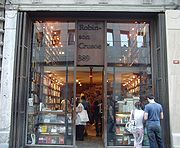
In The Tale of Little Pig Robinson, Beatrix Potter directs the reader to Robinson Crusoe for a detailed description of the island (the land of the Bong tree) to which her eponymous hero moves. She describes the land of the Bong tree as being similar to Robinson Crusoe's, "only without its drawbacks."
In Wilkie Collins's most popular novel, The Moonstone, one of the chief characters and narrators, Gabriel Betteredge has faith in all that Robinson Crusoe says and uses the book for a sort of divination. He considers The Adventures of Robinson Crusoe the finest book ever written and considers a man but poorly read if he had happened not to read the book.
In Kenneth Gardner's award winning 2002 novel Rich Man's Coffin, he portrays the true story of a black American slave who escapes on a whaling ship to New Zealand to become chief of one of the cannibal Maori tribes. This is a reversal of racial roles, with the black man taking the lead role of the Robinson Crusoe figure.
French novelist Michel Tournier wrote Friday (French Vendredi ou les Limbes du Pacifique) published in 1967. His novel explores themes including civilization versus nature, the psychology of solitude as well as death and sexuality in a retelling of Defoe's Robinson Crusoe story. Tournier's Robinson chooses to remain on the island, rejecting civilization when offered the chance to escape 28 years after being shipwrecked.
"Crusoe in England" is a 183-line poem by Elizabeth Bishop.
J. M. Coetzee's 1986 novel Foe recounts the tale of Robinson Crusoe from the aspect of Susan Barton who went on to star in another of DeFoe's novels. In this novel Crusoe is depicted as a much less motivated man and Friday as a mute.
Stage and Film
Jacques Offenbach wrote an opéra comique called Robinson Crusoé which was first performed at the Opéra-Comique, Salle Favart on 23 November 1867. This was based on the British pantomime version rather than the novel itself. The libretto was by Eugène Cormon and Hector-Jonathan Crémieux. The opera includes a duet by Robinson Crusoe and Friday.
Luis Buñuel directed the Adventures of Robinson Crusoe starring Dan O'Herlihy, released in 1954.
The 1964 film Robinson Crusoe on Mars starred Paul Mantee in a science fiction retelling of the story, with "Crusoe" (actually named Colonel Dan McReady) as an astronaut stranded on Mars.
Walt Disney later modernized the novel into a movie called Lt. Robin Crusoe, U.S.N. starring Dick Van Dyke.
In 1988, Aidan Quinn portrayed Robinson Crusoe in the film Crusoe.
A 1997 movie entitled Robinson Crusoe starred Pierce Brosnan and received limited commercial success
Television
In 1964 a French film production crew made a 13 part serial of " The Adventures of Robinson Crusoe". It starred Robert Hoffman. The black and white series was dubbed into English and German. In the UK, the BBC aired it on numerous occasions between 1965 and 1977.
In the mid-1990s there was a humorous French cartoon called Robinson Sucroë. In the cartoon, Robinson was a failed journalist for the New York Herald. Seeking a life of adventure, he desired to settle on an island and wished to write his weekly journal. After getting an okay from his boss, he sets sail and he is left on an uninhabited island (or so he thought). Robinson discovers that the island is inhabited by French and British pirates as well as the survivor of a shipwreck, who called themselves "toutlejours" (the Everydays). Robinson befriend a fellow named Mercredi (Wednesday). Robinson tries to write a colorful journal but he is incapable of doing so, instead Wednesday writes fictitious stories for him. These stories achieve much success and few suspect their authenticity.
In 2008, a television series titled Crusoe aired for 12 episodes. It was loosely on the novel and was not renewed for a second season.
Editions
- Robinson Crusoe, Oneworld Classics 2008. ISBN 978-1-94749-012-4
- Robinson Crusoe, Penguin Classics 2003. ISBN 978-0-14-143982-2
- Robinson Crusoe, Oxford World's Classics 2007. ISBN 978-0-19-283342-6

